Determination of Ferulic Acid in Angelica sinensis by Temperature-Controlled Hydrophobic Ionic Liquids-Based Ultrasound/Heating-Assisted Extraction Coupled with High Performance Liquid Chromatography
Abstract
1. Introduction
2. Materials and Methods
2.1. Materials
2.2. Equipment
2.3. Sample Preparation
2.4. Temperature-Controlled Hydrophobic IL Based Ultrasound/Heating-Assisted Extraction
2.5. Conventional Reference Extraction Procedures
2.6. Scanning Electron Microscopy Analysis (SEM)
2.7. HPLC Analysis
3. Results and Discussion
3.1. Optimization of TC-ILs-UHAE
3.1.1. Selection of the Types of Extraction Solvents
3.1.2. Effect of IL Volume
3.1.3. Effect of Solid–Liquid Ratio
3.1.4. Effect of Extraction Temperature
3.1.5. Effect of Ultrasound Time
3.1.6. Effect of Centrifugal Speed and Time
3.2. Comparison of the Proposed TC-ILs-UHAE with the Conventional Methods
3.3. Analytical Performance
3.4. Analysis of Real Samples
4. Conclusions
Author Contributions
Funding
Conflicts of Interest
References
- Wei, W.L.; Zeng, R.; Gu, C.M.; Qu, Y.; Huang, L.F. Angelica sinensis in China-A review of botanical profile, ethnopharmacology, phytochemistry and chemical analysis. J. Ethnopharmacol. 2016, 190, 116–141. [Google Scholar] [CrossRef]
- Li, P.; Li, S.P.; Lao, S.C.; Fu, C.M.; Kan, K.K.W.; Wang, Y.T. Optimization of pressurized liquid extraction for Z-ligustilide, Z-butylidenephthalide and ferulic acid in Angelica sinensis. J. Pharm. Biomed. Anal. 2006, 40, 1073–1079. [Google Scholar] [CrossRef] [PubMed]
- Yao, W.L.; Zhang, L.; Hua, Y.L.; Peng, J.; Li, P.L.; Li, J.X.; Zhong, L.J.; Zhao, H.F.; Wei, Y.M. The investigation of anti-inflammatory activity of volatile oil of Angelica sinensis by plasma metabolomics approach. Int. Immunopharmacol. 2015, 29, 269–277. [Google Scholar] [CrossRef] [PubMed]
- Lin, P.C.; Liu, P.Y.; Lin, S.Z.; Harn, H.J. Angelica sinensis: A Chinese herb for brain cancer therapy. BioMedicine 2012, 2, 30–35. [Google Scholar] [CrossRef]
- Ma, J.P.; Guo, Z.B.; Jin, L.; Li, Y.D. Phytochemical progress made in investigations of Angelica sinensis (Oliv.) Diels. Chin. J. Nat. Med. 2015, 13, 241–249. [Google Scholar] [CrossRef]
- Chinese Pharmacopoeia Commission. Pharmacopoeia of the People’s Republic of China, 10th ed.; China Medical Science and Technology Press: Beijing, China, 2015; pp. 133–134. [Google Scholar]
- Zhu, T.; Chen, X.; Ge, Q.; Chen, M.; Jia, X.; Wang, X.; Ge, C. Interaction between Zligustilide from Radix Angelica sinensis and human serum albumin. Food Chem. 2015, 186, 292–297. [Google Scholar]
- Guan, X.Q.; Mao, J.L.; Yan, B.; Wang, D.D.; Zhang, X.X.; Zhou, H.L. A comparative study among ferulic acid, caffeic acid content and antioxidation in different extracts of Angelica sinensis. Nat. Prod. Res. Dev. 2018, 30, 2033–2038. [Google Scholar]
- Xin, N.; Luo, C.E.; Mo, Y. Comparison of ferulic acid content in different grades of Angelica sinensis. J. Chin. Med. Mat. 2001, 4, 244–245. [Google Scholar]
- Lu, G.H.; Chan, K.; Leung, K.; Chan, C.L.; Zhao, Z.Z.; Jiang, Z.H. Assay of free ferulic acid and total ferulic acid for quality assessment of Angelica sinensis. J. Chromatogr. A 2005, 1068, 209–219. [Google Scholar] [CrossRef]
- Xi, J.; Luo, S.W. The mechanism for enhancing extraction of ferulic acid from Radix Angelica sinensis by high hydrostatic pressure. Sep. Purif. Technol. 2016, 165, 208–213. [Google Scholar] [CrossRef]
- Sun, Y.Y.; Li, S.F.; Song, H.T.; Tian, S.J. Extraction of ferulic acid from Angelica sinensis with supercritical CO2. Nat. Prod. Res. 2006, 20, 835–841. [Google Scholar] [CrossRef] [PubMed]
- Liu, X.Y.; Liu, C.R.; Qian, H.; Qu, Y.; Zhang, S.B.; Lu, R.H.; Gao, H.X.; Zhou, W.F. Ultrasound-assisted dispersive liquid-liquid microextraction based on a hydrophobic deep eutectic solvent for the preconcentration of pyrethroid insecticides prior to determination by high-performance liquid chromatography. Microchem. J. 2019, 146, 614–621. [Google Scholar] [CrossRef]
- Kaltsa, O.; Lakka, A.; Grigorakis, S.; Karageorgou, L.; Batra, G.; Bozinou, E.; Lalas, S.; Makris, D.P.; Zu, Y.G. A green extraction process for polyphenols from elderberry (Sambucus nigra) flowers using deep eutectic solvent and ultrasound-assisted pretreatment. Molecules 2020, 25, 921. [Google Scholar] [CrossRef] [PubMed]
- Liao, J.Q.; Qu, B.D.; Zheng, N. Optimization of ultrasound-assisted extraction condition for phenolic compounds, antioxidant activity, and epigallocatechin gallate in lipid-extracted microalgae. Molecules 2020, 25, 454. [Google Scholar]
- Wang, L.; Boussetta, N.; Lebovka, N.; Lefebvre, C.; Vorobiev, E. Correlations between disintegration degree of fruit skin cells induced by ultrasound and efficiency of bio-compounds extraction. Ultrason. Sonochem. 2019, 52, 280–285. [Google Scholar] [CrossRef] [PubMed]
- Altunay, N.; Yıldırım, E.; Gürkan, R. Extraction and preconcentration of trace Al and Cr from vegetable samples by vortex-assisted ionic liquid-based dispersive liquid–liquid microextraction prior to atomic absorption spectrometric determination. Food Chem. 2018, 245, 586–594. [Google Scholar] [CrossRef]
- Wang, J.L.; Feng, J.; Xu, L.; Ma, J.P.; Li, J.L.; Ma, R.; Sun, K.; Wang, Z.B.; Zhang, H.Q. Ionic liquid-based salt-induced liquid-liquid extraction of polyphenols and anthraquinones in Polygonum cuspidatum. J. Pharm. Biomed. Anal. 2019, 163, 95–104. [Google Scholar] [CrossRef]
- Liao, Y.Y.; Hou, Y.G.; Zhong, Y.; Chen, H.; Xu, C.; Tsunoda, M.; Zhang, Y.X.; Deng, S.M.; Song, Y.T. One-step ionic liquid-based ultrasound-assisted dispersive liquid-liquid microextraction coupled with high-performance liquid chromatography for the determination of pyrethroids in traditional Chinese medicine oral liquid preparations. BMC Chem. 2019, 13, 61. [Google Scholar] [CrossRef]
- Fan, Y.C.; Xu, C.; Li, J.; Zhang, L.; Yang, L.; Zhou, Z.L.; Zhu, Y.H.; Zhao, D. Ionic liquid-based microwave-assisted extraction of verbascoside from Rehmannia root. Ind. Crop. Prod. 2018, 124, 59–65. [Google Scholar] [CrossRef]
- Wu, H.W.; Chen, M.L.; Fan, Y.C.; Elsebaei, F.; Zhu, Y. Determination of rutin and quercetin in Chinese herbal medicine by ionic liquid-based pressurized liquid extraction-liquid chromatography–chemiluminescence detection. Talanta 2012, 88, 222–229. [Google Scholar] [CrossRef]
- Li, S.L.; Li, S.N.; Huang, Y.; Liu, C.M.; Chen, L.N.; Zhang, Y.C. Ionic-liquid-based ultrasound-assisted extraction of isoflavones from Belamcanda chinensis and subsequent screening and isolation of potential α-glucosidase inhibitors by ultrafiltration and semipreparative high-performance liquid chromatography. J. Sep. Sci. 2017, 40, 2565–2574. [Google Scholar] [CrossRef] [PubMed]
- Wei, J.F.; Cao, P.R.; Wang, J.M.; Kang, W.Y. Analysis of tilianin and acacetin in Agastache rugosa by high-performance liquid chromatography with ionic liquids-ultrasound based extraction. Chem. Cent. J. 2016, 10, 76. [Google Scholar] [CrossRef] [PubMed]
- Bi, W.T.; Tian, M.L.; Row, K.H. Ultrasonication-assisted extraction and preconcentration of medicinal products from herb by ionic liquids. Talanta 2011, 85, 701–706. [Google Scholar] [CrossRef] [PubMed]
- Santos, A.P.; dos Santos, M.J.; Korn, M.; das Graças Andrade Korn, M.; Lemos, V.A. Determination of cadmium in bread and biscuit samples using ultrasound-assisted temperature-controlled ionic liquid microextraction. J. Sci. Food Agr. 2019, 99, 4609–4614. [Google Scholar] [CrossRef] [PubMed]
- Albishri, H.M.; Aldawsari, N.A.M.; El-Hady, D.A. Ultrasound-assisted temperature-controlled ionic liquid dispersive liquid-phase microextraction combined with reversed-phase liquid chromatography for determination of organophosphorus pesticides in water samples. Electrophoresis 2016, 37, 2462–2469. [Google Scholar] [CrossRef]
- Zhou, Q.X.; Bai, H.H.; Xie, G.H.; Xiao, J.P. Temperature-controlled ionic liquid dispersive liquid phase micro-extraction. J. Chromatogra. A 2008, 1177, 43–49. [Google Scholar] [CrossRef]
- Bai, H.H.; Zhou, Q.X.; Xie, G.H.; Xiao, J.P. Temperature-controlled ionic liquid-liquid-phase microextraction for the pre-concentration of lead from environmental samples prior to flame atomic absorption spectrometry. Talanta 2010, 80, 1638–1642. [Google Scholar] [CrossRef]
- Fan, Y.C.; Chen, M.L.; Shentu, C.; El-Sepai, F.; Wang, K.X.; Zhu, Y.; Ye, M.L. Ionic liquids extraction of Para Red and Sudan dyes from chilli powder, chilli oil and food additive combined with high performance liquid chromatography. Anal. Chim. Acta 2009, 650, 65–69. [Google Scholar] [CrossRef]
- Yu, Y.Y.; Zhang, W.; Cao, S.W. Extraction of ferulic acid and caffeic acid with ionic liquids. Chinese J. Anal. Chem. 2007, 35, 1726–1730. [Google Scholar]
- Fan, Y.C.; Li, X.J.; Zhang, L.; Duan, P.G.; Li, F.F.; Zhao, D.; Wang, Y.; Wu, H.W. Ether-functionalized ionic liquids: Highly efficient extractants for hordenine. Chem. Eng. Res. Des. 2017, 124, 66–73. [Google Scholar] [CrossRef]
- Han, C.; Yu, G.R.; Wen, L.; Zhao, D.C.; Asumana, C.; Chen, X.C. Data and QSPR study for viscosity of imidazolium-based ionic liquids. Fluid Phase Equilibr. 2011, 300, 95–104. [Google Scholar] [CrossRef]
Sample Availability: Samples of the compounds are available from the authors. |
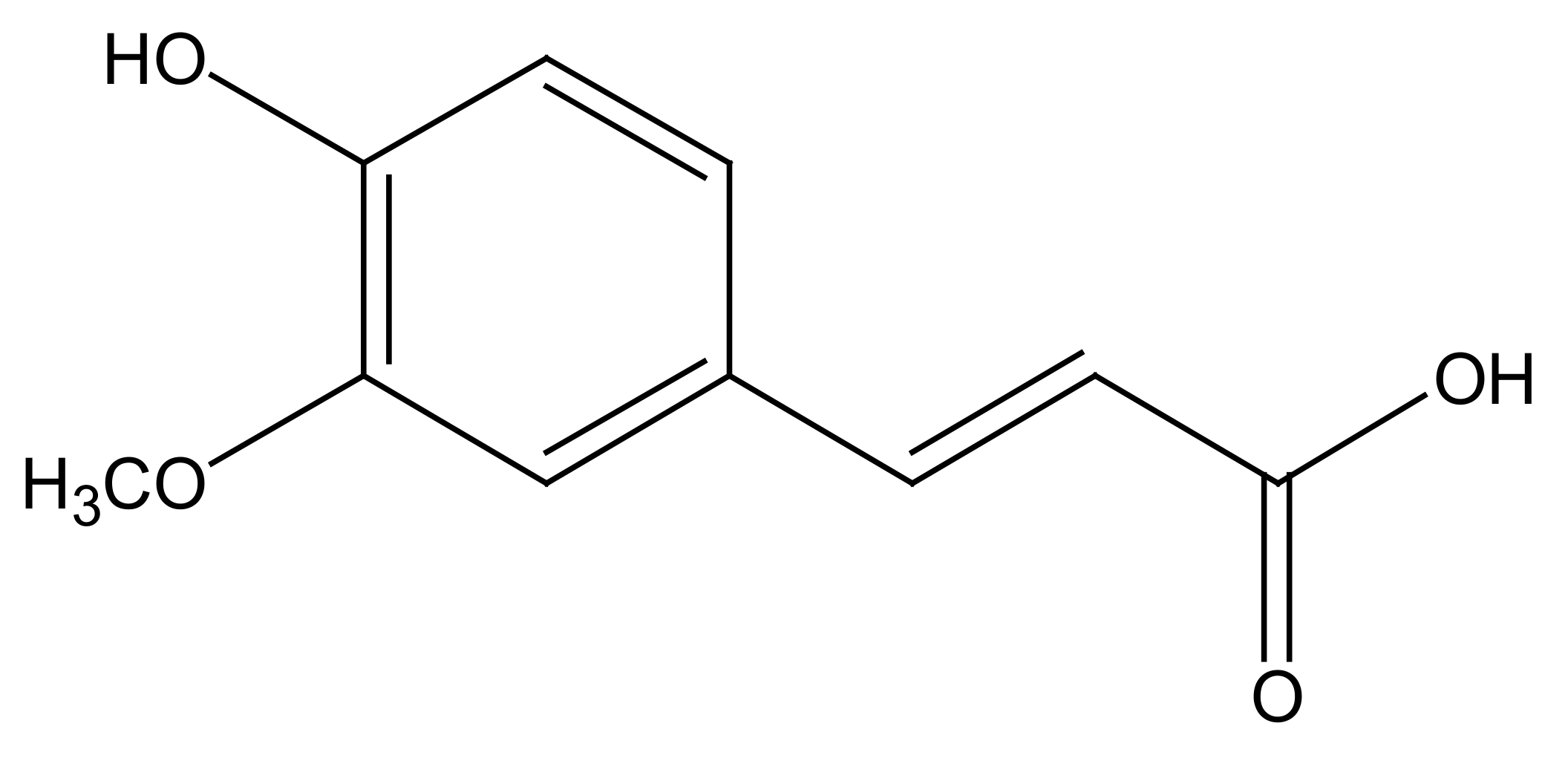

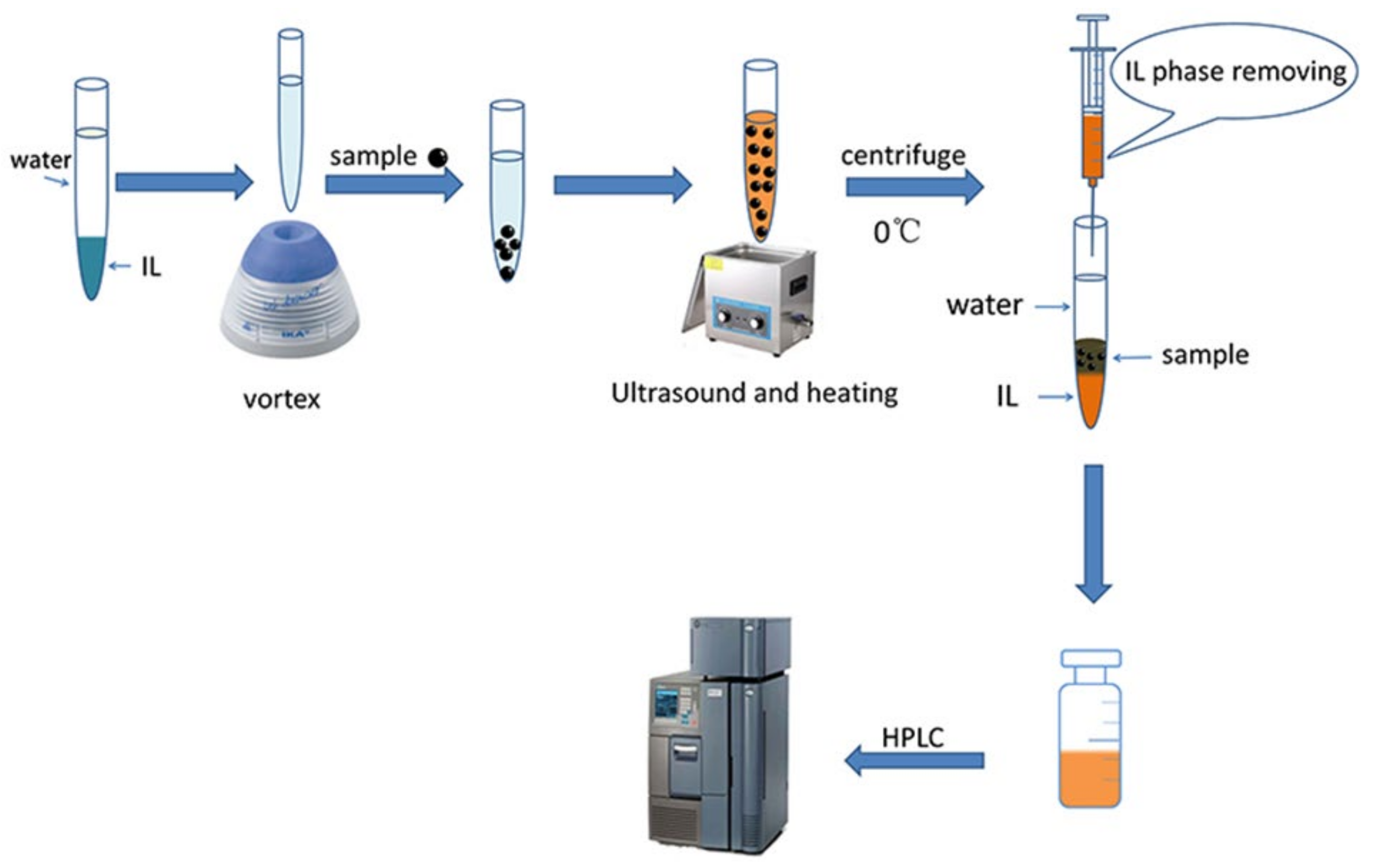
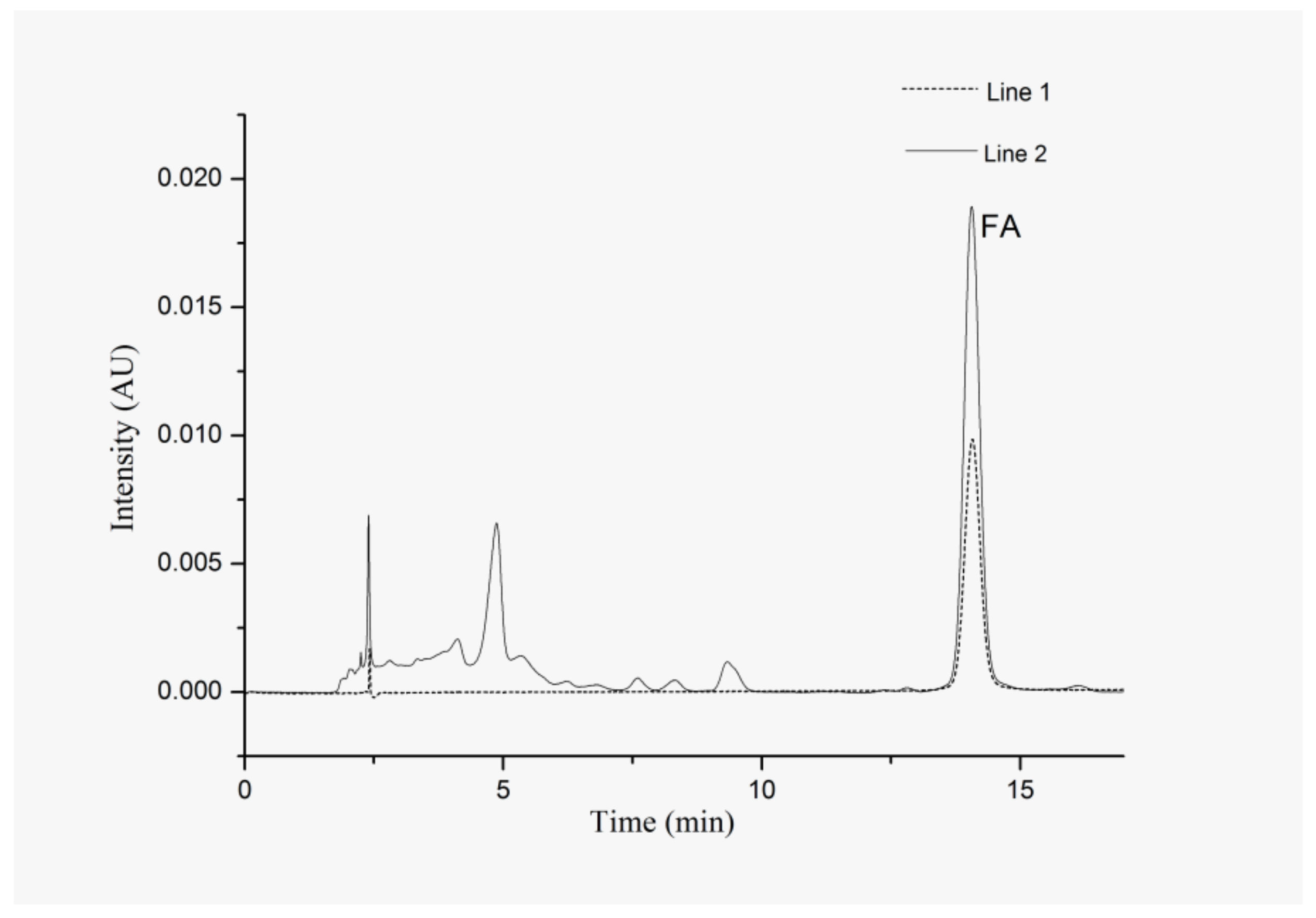
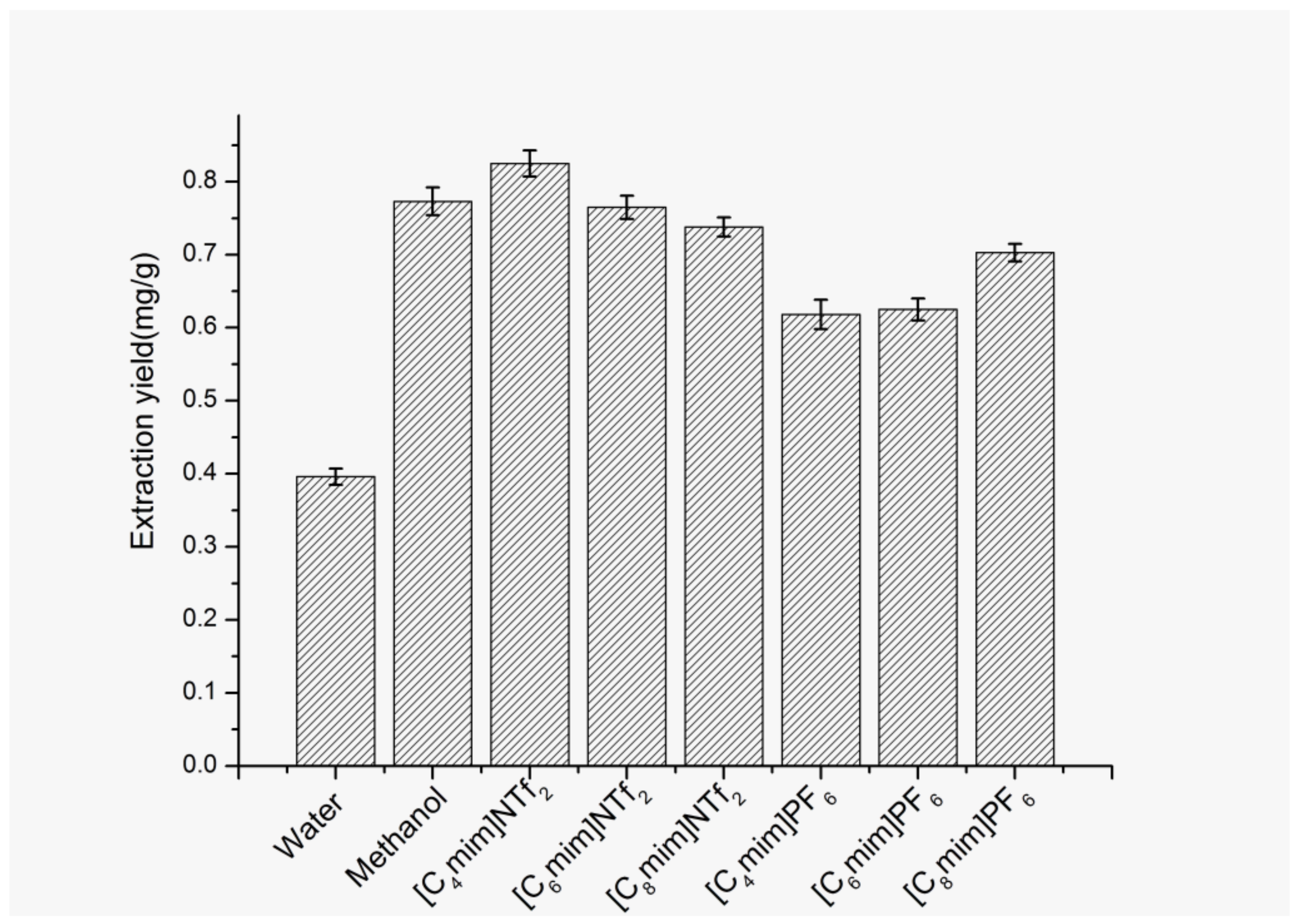

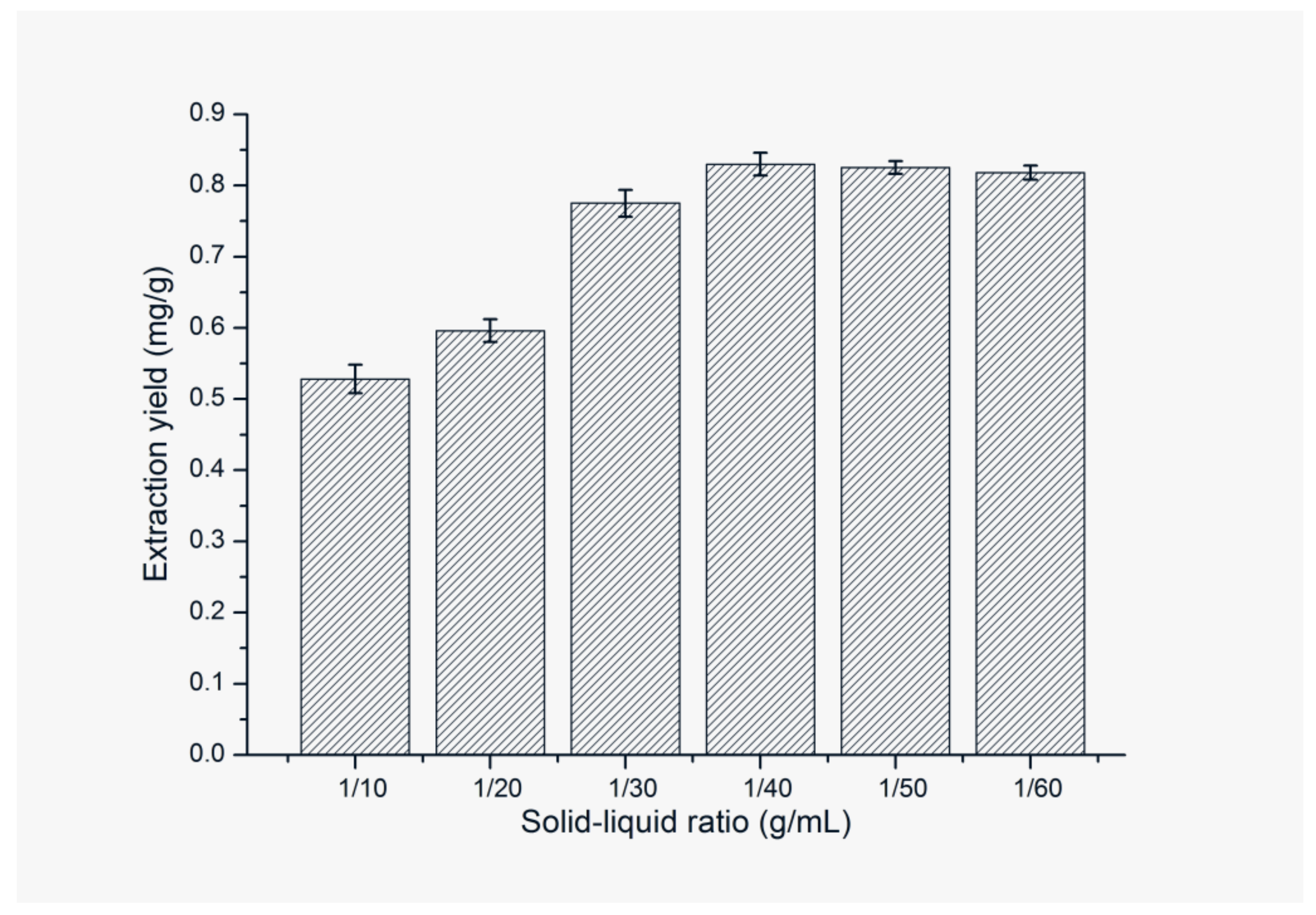
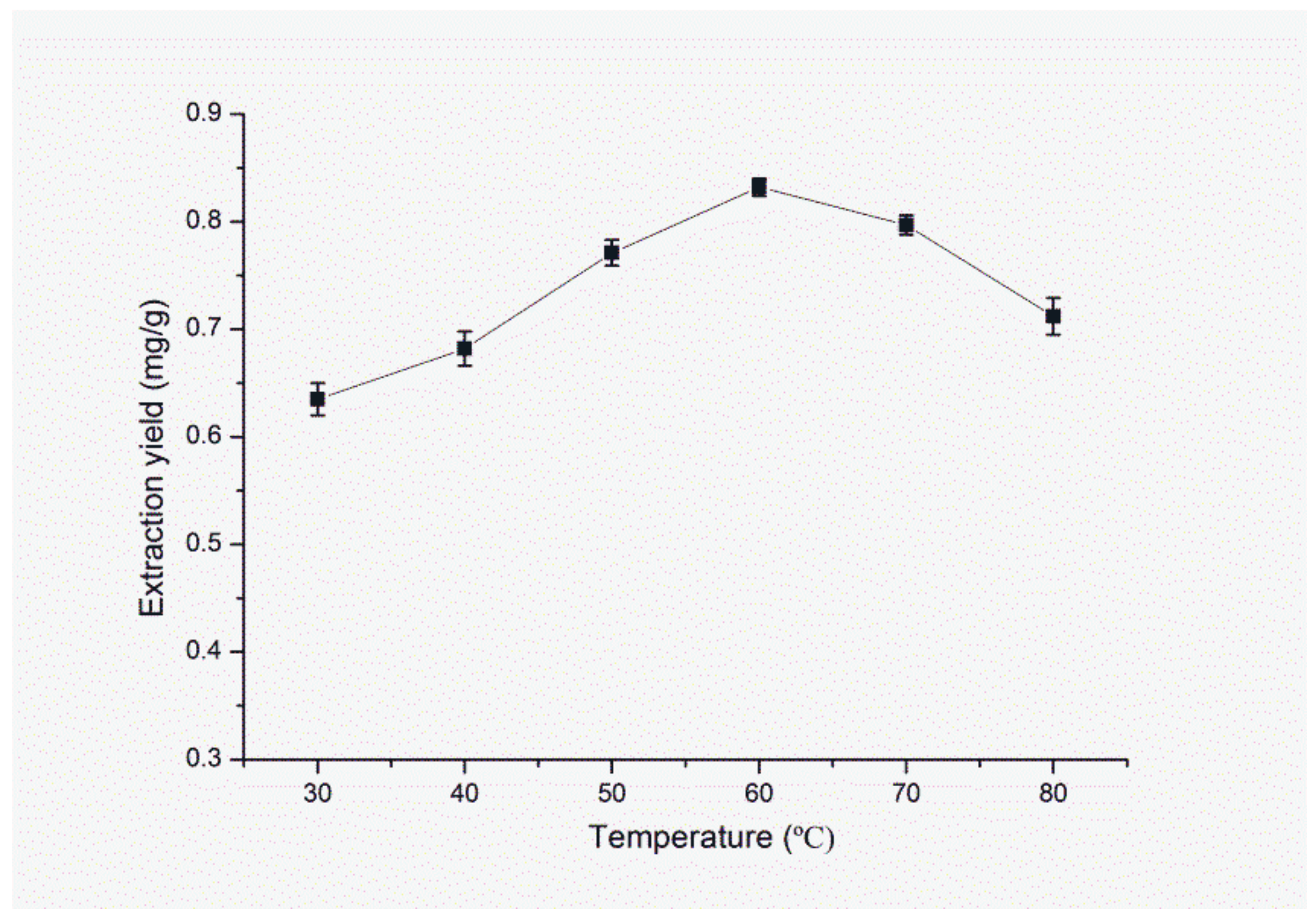

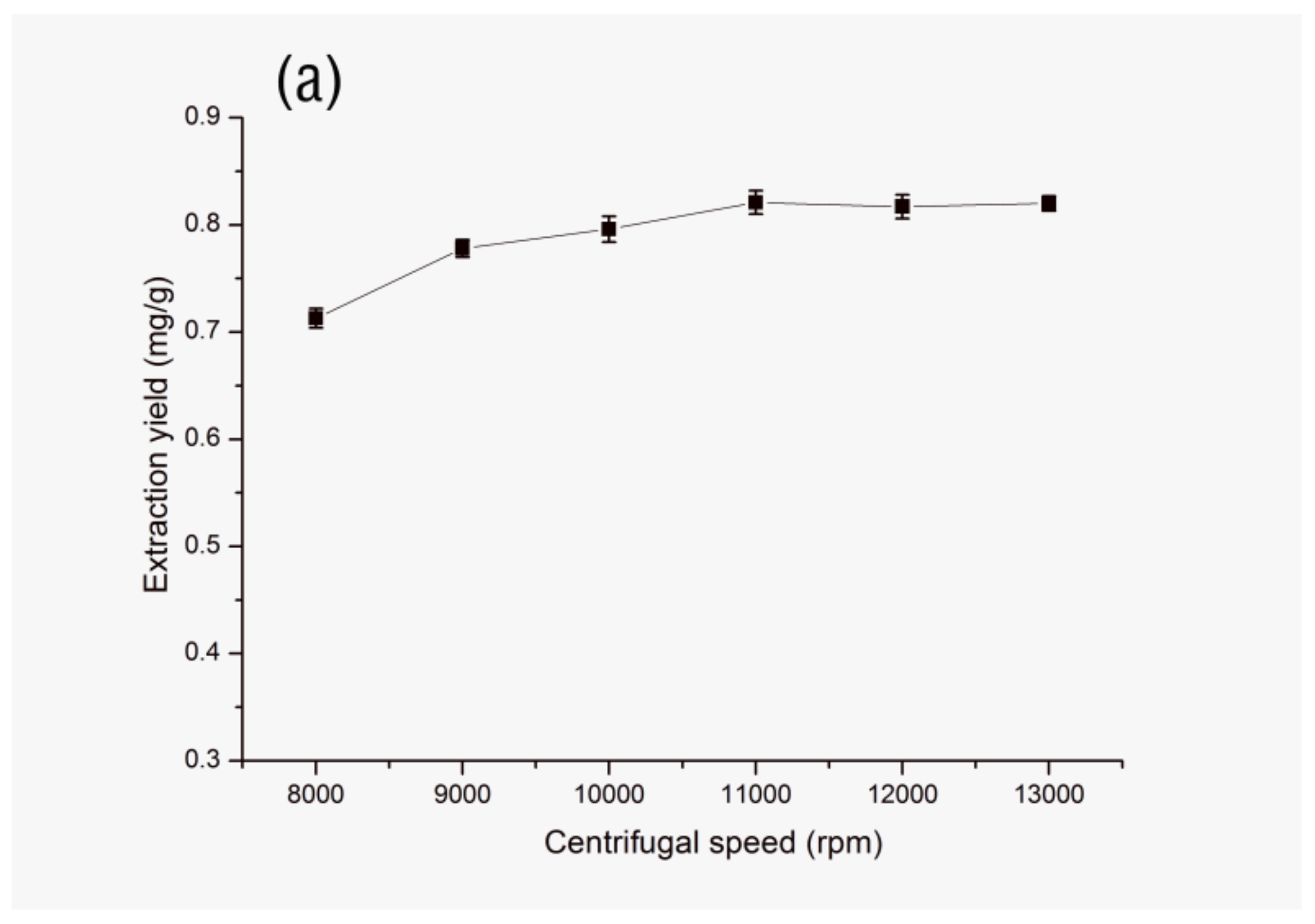
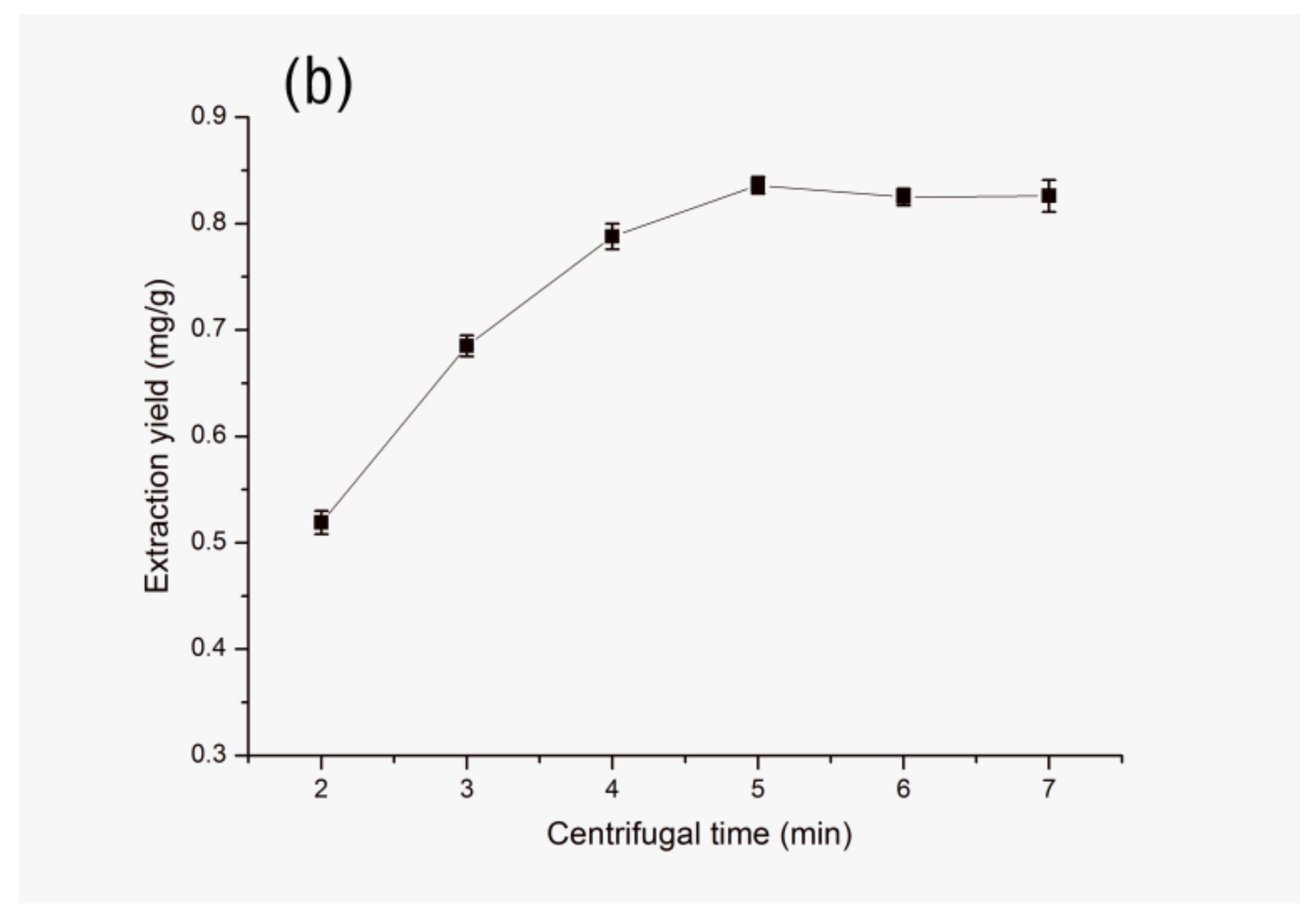

| Method | Extraction Yield (mg/g) | Sample Amount (mg) | Solvent | Volume of Solvent (mL) | Extraction Time (min) |
|---|---|---|---|---|---|
| TC-ILs-UHAE | 0.83 ± 0.015 a | 50 | [C4mim]NTf2 | 0.8 | 9 |
| HRE | 0.68 ± 0.011 | 200 | [C4mim]NTf2 | 8 | 60 |
| Pharmacopoeia | 0.81 ± 0.012 | 200 | Methanol | 20 | 30 |
| Original (mg/g) | Added (mg/g) | Recovery (%) | RSD (%, n = 5) | |
|---|---|---|---|---|
| FA | 0.83 | 1.00 | 102.00 | 2.65 |
| 0.80 | 93.75 | 1.53 | ||
| 0.60 | 91.67 | 3.87 |
| Sample Number | Cultivation Region | Extraction Yield (mg/g) | RSD (%, n = 5) |
|---|---|---|---|
| 1 | Gansu | 0.83 | 3.15 |
| 2 | Gansu | 0.86 | 2.26 |
| 3 | Gansu | 0.82 | 2.87 |
| 4 | Gansu | 0.78 | 1.55 |
| 5 | Yunnan | 0.66 | 3.62 |
| 6 | Yunnan | 0.73 | 1.68 |
© 2020 by the authors. Licensee MDPI, Basel, Switzerland. This article is an open access article distributed under the terms and conditions of the Creative Commons Attribution (CC BY) license (http://creativecommons.org/licenses/by/4.0/).
Share and Cite
Wu, H.; Huang, Q.; Chao, S.; Yu, J.; Xu, S.; Wang, F.; Shang, X.; Zhu, Y. Determination of Ferulic Acid in Angelica sinensis by Temperature-Controlled Hydrophobic Ionic Liquids-Based Ultrasound/Heating-Assisted Extraction Coupled with High Performance Liquid Chromatography. Molecules 2020, 25, 3356. https://doi.org/10.3390/molecules25153356
Wu H, Huang Q, Chao S, Yu J, Xu S, Wang F, Shang X, Zhu Y. Determination of Ferulic Acid in Angelica sinensis by Temperature-Controlled Hydrophobic Ionic Liquids-Based Ultrasound/Heating-Assisted Extraction Coupled with High Performance Liquid Chromatography. Molecules. 2020; 25(15):3356. https://doi.org/10.3390/molecules25153356
Chicago/Turabian StyleWu, Hongwei, Qianqian Huang, Shujun Chao, Jie Yu, Shengrui Xu, Feng Wang, Xuefang Shang, and Yan Zhu. 2020. "Determination of Ferulic Acid in Angelica sinensis by Temperature-Controlled Hydrophobic Ionic Liquids-Based Ultrasound/Heating-Assisted Extraction Coupled with High Performance Liquid Chromatography" Molecules 25, no. 15: 3356. https://doi.org/10.3390/molecules25153356
APA StyleWu, H., Huang, Q., Chao, S., Yu, J., Xu, S., Wang, F., Shang, X., & Zhu, Y. (2020). Determination of Ferulic Acid in Angelica sinensis by Temperature-Controlled Hydrophobic Ionic Liquids-Based Ultrasound/Heating-Assisted Extraction Coupled with High Performance Liquid Chromatography. Molecules, 25(15), 3356. https://doi.org/10.3390/molecules25153356






